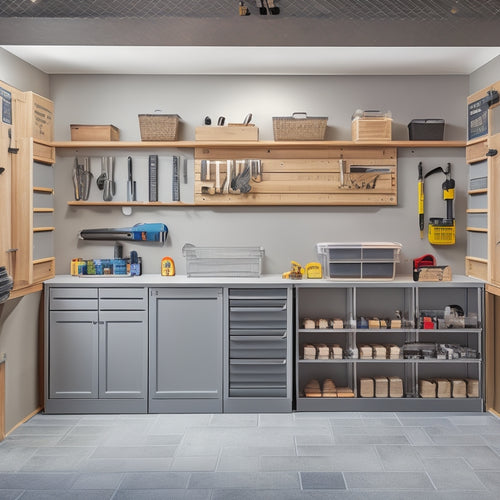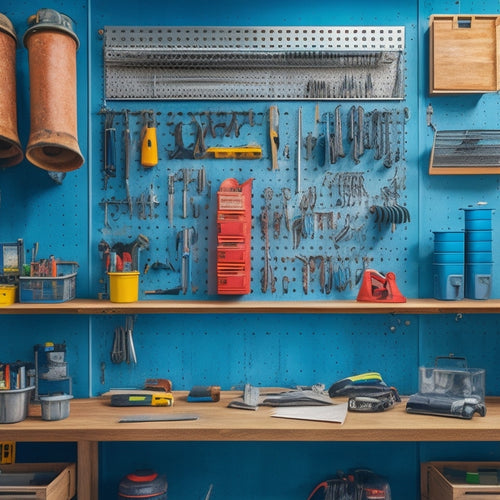
Organize Your Storage Bins in 3 Steps
Share
To organize your storage bins in 3 steps, start by purging and categorizing contents - gather bins, empty them, and group similar items, prioritizing what you use most and discarding what you haven't used in a year. Next, assign and label bins clearly, using a permanent marker to identify what's inside, and consider color-coding or numbering systems. Finally, maintain and refine your system by performing quarterly checks, making seasonal adjustments, and monitoring storage efficiency to optimize space and prevent clutter. Now that you've got a solid foundation, uncover how to further optimize your storage solutions for long-term success.
Key Takeaways
- Gather storage bins, empty contents, and group similar items to prioritize and discard unused or damaged items.
- Assign and label bins clearly with permanent markers, including brief descriptions, and consider color-coding or numbering systems.
- Perform quarterly checks to review and organize bin contents, making seasonal adjustments and refining the system as needed.
- Ensure labels are easy to read and understand, and that the system is safe and accessible for all users.
- Regularly maintain and refine the system to optimize storage space, prevent clutter, and improve overall organization.
Purge and Categorize Contents
With your storage bins gathered, begin by taking everything out of them. This will give you a clear view of what you have and help you decide what to keep, donate, or discard.
Start by grouping similar items together, such as seasonal decorations or out-of-season clothing. This is a key declutter strategy that will make it easier to prioritize your items.
Next, go through each group and prioritize the items. Be honest with yourself – do you really need that item, or can you let it go? Consider the last time you used it and whether it's still in good condition. If you haven't used it in a year, it's probably safe to get rid of it. Set aside items that are broken or damaged beyond repair.
As you sort through your items, remember to handle them safely. If you're dealing with sharp objects or heavy items, take your time and be careful not to hurt yourself.
Assign and Label Bins
Now that you've purged and categorized your items, you're ready to assign them a home in your storage bins. Start by identifying the types of bins you need. You may require small bins for tiny items like beads or buttons, medium bins for toys or craft supplies, and large bins for bulky items like blankets or seasonal decorations.
Once you have the right bin types, it's time to label them. Clear labeling is essential for maintaining organization and ensuring you can quickly find what you need. Use a permanent marker to write the contents of each bin on the outside. You can also add a brief description or category to help you narrow down your search. For example, instead of just labeling a bin "Toys," you could write "Building Toys" or "Dolls and Accessories."
Consider using color-coding or numbering systems to further categorize your bins. This will help you visualize your storage system and make it easier to locate specific items.
Maintain and Refine System
You've successfully organized your storage bins, but your work isn't done yet. To maintain your newly organized storage system, you'll need to refine and adjust it regularly. This will guarantee that your storage bins continue to serve you efficiently and safely.
Here are 3 essential maintenance tasks to prioritize:
-
Perform quarterly checks: Set aside time every 3 months to review your storage bins' contents and confirm everything is still organized and easily accessible.
-
Make seasonal adjustments: As the seasons change, so do your storage needs. Update your storage bins to reflect these changes, such as swapping out winter gear for summer equipment.
-
Monitor storage efficiency: Keep an eye on how well your storage system is performing and make adjustments as needed. This will help you optimize your storage space and prevent clutter from building up again.
Frequently Asked Questions
Can I Use Old Containers or Do I Need New Bins?
You can definitely repurpose old containers, but consider their condition and storage aesthetics - if they're worn or mismatched, new bins might be a better bet for a safe and visually pleasing storage solution.
How Do I Organize Bins in a Small or Cramped Space?
When dealing with small or cramped spaces, you'll need to employ space-saving techniques, like vertical storage, to maximize your storage capacity. You can use stackable bins or shelves to keep items off the floor, creating more room to move around safely.
What if I Have Oversized Items That Won't Fit in Bins?
You're renovating your tiny apartment and need to store a bulky sectional sofa; consider installing floor-to-ceiling shelves or a murphy bed to accommodate oversized furniture, requiring creative solutions for a clutter-free space.
Can I Involve My Kids in the Organization Process?
You can definitely involve your kids in organizing storage bins, teaching them important teamwork benefits and developing their organizational skills.
How Often Should I Reassess My Storage Bin Organization System?
Just like a gardener tends to their garden, you should regularly tend to your storage bin organization system; schedule a frequency check every few months and a seasonal review to guarantee your system remains functional and safe for you and your kids.
Conclusion
You've finally tamed the storage bin beast! Now, you can find what you need in seconds. But, will you let clutter creep back in, or will you maintain your newfound organization? By following these three simple steps, you'll be more likely to keep your storage bins organized and your sanity intact. Remember, a little maintenance goes a long way. Stay on top of your storage game and enjoy the peace of mind that comes with it!
Related Posts
-

Essential Steps for Garage Storage System Design
You're about to change your cluttered garage into an organized haven by following a structured approach to garage sto...
-

Top Wrench Tool Box Sets for Every Mechanic
You're looking for high-quality wrench tool box sets that cater to your specific needs as a mechanic. From top-rated ...
-

Custom Pegboard Storage for Your Workshop
You're looking to create a custom pegboard storage system that maximizes your workshop's space, enhances productivity...


